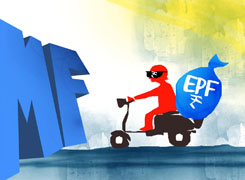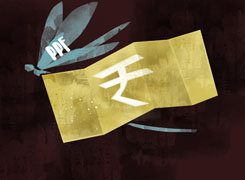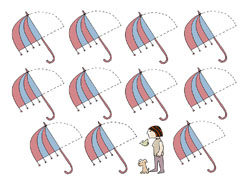Hi, I have a query regarding EPF balance transfer.
I used to work with Firm A & Firm B and currently working in Firm C.
I initiated a EPF balance transfer from Firm A to Firm C and from Firm B to Firm C.
Firm A to Firm C was successful.
Firm B to Firm C was rejected with below 2 reasons.
1)Pension contribution on higher wages.
2) Claim already settled.
Please advise what are those reasons for rejection as I'm unable to understand them.
Also note I have only 1 UAN number.
Thanks.
Ans: You have taken the right step by initiating EPF transfers. Keeping one UAN and consolidating all your EPF balances helps with better tracking and planning. However, it is important to clearly understand why your EPF transfer from Firm B to Firm C got rejected.
Let’s understand both the reasons given for the rejection in a very simple and clear manner.
What does “Pension Contribution on Higher Wages” mean?
In EPF, the pension part (EPS) has a salary ceiling.
The ceiling is Rs. 15,000 per month for pension calculation.
That means, pension is calculated on Rs. 15,000 even if your salary was more.
But some companies contribute on actual salary, which is above Rs. 15,000.
This is called “higher wages” pension contribution.
Firm B likely contributed EPS on your full salary (not limited to Rs. 15,000).
This is not standard as per EPFO’s default system.
So, EPFO sometimes rejects transfer of EPS part if higher wages were used.
This rule is strictly followed after 2014.
Many employers still use old rules or make manual changes.
That is likely why EPFO flagged and rejected your EPS transfer.
But your EPF (Provident Fund) part is safe. This issue is only with the pension part.
You should check with Firm B’s HR or EPF consultant.
Ask them if they contributed EPS on full salary or just on Rs. 15,000.
You can also get a wage-wise contribution statement from EPFO portal.
This statement will show how much went into EPS each month.
If EPS was wrongly calculated on higher salary, transfer may not happen.
You may need to write to your PF office for a manual correction.
In some cases, only EPF part gets transferred, not EPS.
EPS part stays with the earlier employer as “non-transferable.”
What does “Claim Already Settled” mean?
This reason generally means EPFO has already processed something for Firm B.
It could mean you withdrew the EPF or EPS money from Firm B earlier.
Or you made a claim for Firm B’s EPF before this transfer request.
It could also mean the transfer was already done earlier, maybe from B to A.
If the record shows it as settled, EPFO rejects repeat requests.
You should carefully check your passbook in EPFO portal.
Login with your UAN and check if Firm B’s balance is zero.
If you already got the money before, it’s treated as settled.
If the transfer was already completed earlier, no new transfer is needed.
Sometimes due to technical delay, even successful claims show as rejected.
That’s why you must check your EPFO statement for every employer.
Look under “View –> Service History” and “Passbook” in your EPF portal.
Why this matters for your financial planning?
If EPS is stuck, it impacts your pension eligibility after retirement.
But this doesn’t affect your EPF (Provident Fund) balance.
EPF part earns interest and grows your retirement corpus.
EPS is used to calculate monthly pension under EPS-95 scheme.
For people with higher salaries, the pension amount is already low.
So, EPS may not give you much benefit if you cross Rs. 15,000 salary.
Still, transferring it helps you meet pension service years criteria.
That’s why correcting this issue is important, even if amount is small.
Steps You Should Take Now
Step 1: Log in to EPFO portal with your UAN.
Step 2: Go to “Service History” and check all your previous jobs.
Step 3: Check passbook for Firm B. See if amount is zero or already transferred.
Step 4: Ask HR of Firm B whether they deposited EPS on actual salary.
Step 5: Ask if any withdrawal was done in the past from Firm B EPF.
Step 6: If needed, raise grievance on EPFO portal (https://epfigms.gov.in).
Step 7: Submit a letter to EPFO office for manual EPS transfer approval.
Step 8: Keep screenshots of all rejection messages and passbook entries.
Common Mistakes in EPF Transfer Process
Using different UANs: You did not make this mistake. So that’s good.
Applying partial transfers: One must always apply from oldest to newest employer.
Missing EPS service records: EPS part often remains unlinked or unrecorded.
Multiple claims for same job: EPFO auto rejects duplicate requests.
How This Affects Retirement Plan?
You are consolidating your EPF balance, which is a strong financial move.
EPF gives tax-free interest and acts as a stable retirement base.
EPS gives fixed pension post 58 years if you complete 10 service years.
If service is broken, pension eligibility may be lost.
That’s why it is important to fix pension service records.
Even if EPS amount is low, it helps in eligibility.
At retirement, EPF + Mutual Funds + PPF + NPS gives strong retirement base.
Do not ignore small issues like EPS transfer.
Should You Worry Too Much?
Not at all. Your EPF money is still growing.
EPS is only a small benefit if your salary was always above Rs. 15,000.
But correcting service record is important.
So take this up with EPFO and Firm B HR.
Once resolved, you can reapply for EPS transfer.
Tips to Maintain EPF in Future
Always link new job to same UAN.
Transfer EPF within 6 months of job change.
Check EPF passbook once every 6 months.
Keep KYC (Aadhaar, PAN, Bank) updated in EPFO.
Download service history and passbook regularly.
Final Insights
You took the right action by initiating the transfer.
One transfer succeeded, which is good progress.
The rejection is because of special rules in EPS and possible past claim.
Check your passbook and service history.
Talk to Firm B HR and raise a grievance to EPFO.
Keep your EPF account consolidated for better long-term tracking.
Your retirement plan will be strong with EPF as a stable foundation.
For growth, continue investing monthly in mutual funds through a CFP.
Avoid direct mutual funds. They lack the ongoing guidance of an expert.
Direct plans can miss out on scheme suitability, reviews, and changes.
Regular mutual funds via a certified planner help in asset allocation.
They ensure your investments are matched to your risk and goals.
For a stress-free retirement, all small record errors must be corrected early.
Keep all your employer data clean and updated on EPF portal.
Maintain a record of your total EPF, EPS, and service history always.
Best Regards,
K. Ramalingam, MBA, CFP
Chief Financial Planner,
www.holisticinvestment.in
https://www.youtube.com/@HolisticInvestment























